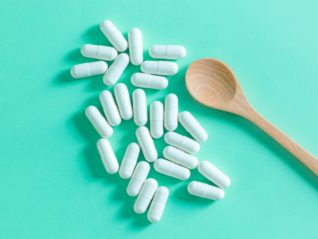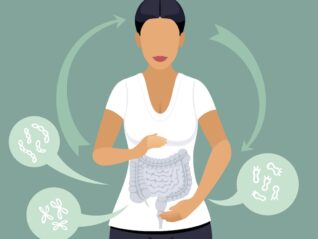
By: Yekta Dowlati, PhD
GLP-1 receptor agonists (GLP-1 RAs), including semaglutide and liraglutide, have redefined therapeutic strategies for type 2 diabetes and obesity by harnessing incretin biology to achieve profound metabolic benefits.1 These agents enhance glucose-dependent insulin secretion, suppress glucagon, delay gastric emptying, and reduce appetite through central and peripheral pathways. However, the same physiological mechanisms that underpin their efficacy are intrinsically linked to gastrointestinal (GI) side effects—an area of growing clinical significance.2
Nausea, early satiety, bloating, diarrhea, and constipation are not peripheral inconveniences; they are direct manifestations of GLP-1’s actions on the gut-brain axis, enteric motility, and digestive secretions.2 In pivotal trials, nausea occurs in up to 50% of patients, constipation in 35%, and diarrhea in 25%, with real-world registries suggesting even higher incidences.3 These adverse effects are a leading cause of early discontinuation, undermining long-term cardiometabolic outcomes despite their generally transient nature.
These side effects are usually dose-dependent and tend to peak during dose escalation.3 Yet for many patients, these symptoms persist beyond initial titration. They often respond by skipping meals, avoiding fiber-rich or nutrient-dense foods, or defaulting to bland, low-variety diets that compromise nutrient status.3,4 For clinicians, this is not merely a matter of comfort—disruptions in gut function reverberate across immune regulation, micronutrient assimilation, and neuroendocrine signaling.
Physiology: Why These Symptoms Arise
The GI manifestations of GLP-1 therapy are underpinned by complex neurohormonal and enteric mechanisms:
Delayed gastric emptying is a primary driver. GLP-1 modulates vagal efferents, dampens antral contractions, and increases pyloric tone, collectively prolonging gastric retention time.5 This augments postprandial satiety but frequently precipitates early fullness, bloating, and nausea, especially as solid-phase emptying is disproportionately slowed.
Central appetite suppression occurs via GLP-1 receptor activation in the arcuate nucleus and nucleus tractus solitarius, attenuating orexigenic signaling.2 While pivotal for caloric reduction, this also compounds voluntary reductions in meal size, potentially diminishing intake of both macronutrients and critical micronutrients.
Altered small intestinal motility results from decreased excitatory cholinergic activity within the enteric nervous system. This slows nutrient progression through the gut and may disrupt coordinated secretions and absorption.6 Additionally, GLP-1 reduces gastric accommodation, lowering the threshold at which gastric stretch receptors trigger sensations of fullness.7
Gallbladder is also impacted. GLP-1 can blunt cholecystokinin (CCK)-mediated gallbladder contraction, impairing bile ejection, especially when combined with low dietary fat intake. Over time, this may promote biliary stasis and elevate risk for cholelithiasis—a concern amplified by rapid weight loss itself.8
Together, these mechanisms explain why nausea, diminished appetite, and altered bowel patterns are prevalent side effects of GLP-1 therapy, and why they are closely linked to unintended reductions in nutrient intake and overall treatment adherence.
Gut Microbiome Disruption: A New Frontier of Concern
Beyond motility, GLP-1 therapies exert secondary effects on the gut microbiota.9 Reduced intake of fermentable substrates, altered transit, and local pH shifts have been shown in preclinical models to modulate Firmicutes-to-Bacteroidetes ratios and short-chain fatty acid (SCFA) outputs.10 While human data remain nascent, maintenance of microbial diversity is critical for mucosal immunity, epithelial barrier integrity, and micronutrient bioavailability.
Patients with pre-existing dysbiosis or microbiome sensitivity may experience exacerbated GI distress under GLP-1–induced ecological shifts, emphasizing the need for microbiome-centric interventions to safeguard gut and systemic health.10
Gastroparesis: A Compounding Complication
In a small subset of patients, GLP-1 therapy may precipitate or unmask gastroparesis—characterized by markedly delayed gastric emptying independent of obstruction.3,11,12 This is typified by refractory fullness, nausea, and bloating. Although not an absolute contraindication, prudent dietary modification (smaller, frequent meals) alongside targeted gastrointestinal support—including low-bloat prebiotics, motility-compatible probiotics, and gut-calming postbiotics—may enhance tolerability and nutrient assimilation.
Biliary Disorders and Hepatobiliary Considerations
GLP-1–mediated suppression of CCK signaling, coupled with reduced duodenal flow and slowed intestinal transit, fosters gallbladder hypomotility.7,8 This environment favors bile concentration and sludge formation, elevating the risk of cholesterol gallstones—particularly amidst rapid adipose mobilization. Strategies incorporating nutrients that support hepatic methylation, bile acid conjugation, and phase I/II detoxification—including choline, taurine, methionine, and traditional cholagogues—may mitigate these risks.13
The Clinical Imperative: Support Tolerance, Sustain Outcomes
Optimal tolerability is indispensable for adherence. Unmanaged GI distress frequently escalates discontinuation rates, undermining metabolic targets and reversing cardiometabolic gains.3 Thus, a proactive, precision-nutrition approach is paramount.
Dietary Strategies That Work—But Only Go So Far
The literature supports a “start low, go slow” titration approach, combined with dietary modifications: low-fat meals, smaller portions, and reduced fiber during initiation phases.3 Hydration, gentle movement, and trigger-avoidance (e.g., spicy foods, carbonation) are also advised.3
But what about those who still struggle despite best practices? Increasingly, HCPs are turning to adjunctive interventions that fortify the gut barrier, support microbial balance, and enhance motility.
A Science-Driven Microbiome-Gut Support Paradigm
To support patients experiencing GI discomfort while on GLP-1 therapy, a targeted, multi-pronged approach is warranted.3 Three clinically validated strategies can bolster GI tolerance, safeguard barrier integrity, and harmonize microbial ecosystems: help ease symptoms, reinforce barrier function, and promote microbial balance:
1. GI-Compatible Prebiotic Fibers
Select prebiotic fibers such as partially hydrolyzed guar gum or pectin-based fibers can help normalize bowel motility and stool consistency without excessive gas or bloating. These fibers also act as fuel for beneficial microbes, enhancing SCFAs production and mucosal integrity. Formulations combining gentle fibers with digestive enzymes or soothing botanicals can further enhance tolerance.14,15
2. Strain-Specific Probiotics
Not all probiotics are created equal. For example, Lactobacillus acidophilus NCFM, Bifidobacterium lactis Bi-07, B. lactis B420, Bacillus subtilis DE111, and Bacillus clausii SNZ 1969 offer targeted effects on gut motility, immune signaling, and enhancing gut barrier function.16-19 These strains have demonstrated benefits in supporting GI comfort, maintaining microbial balance during caloric restriction, and reinforcing mucosal immunity under therapeutic stress.
3. Next-Generation Postbiotic Compounds
Postbiotics—the bioactive metabolites produced by beneficial microorganisms—are gaining traction as a novel category for GI and systemic health. Butyrate analogs, microbial fermentation products, and heat-treated bacterial fractions can help reinforce tight junction integrity, reduce local inflammation, and support tolerance during gut stress. A prime example is pasteurized Akkermansia muciniphila which exerts significant effects on mucosal immune signaling and epithelial integrity.20,21
Importantly, formulations that integrate live probiotic strains alongside targeted postbiotic fractions may achieve synergistic benefits—simultaneously reinforcing microbial equilibrium and augmenting mucosal immune preparedness. Complementary inclusion of key lipotropic and methylation-supportive nutrients—such as choline, methionine, myo-inositol, and select B vitamins—can further enhance outcomes by promoting healthy hepatic lipid metabolism and detoxification pathways. This combined strategy not only protects the gut barrier but also supports efficient liver processing of fats and bile dynamics, which is especially critical during the rapid weight shifts often accompanying GLP-1 therapy.
Putting It All Together: Clinical Nutrition for Gut and Hepatic Resilience
GLP-1 therapies deliver powerful metabolic dividends, but their GI impacts demand equally sophisticated countermeasures. By leveraging integrative protocols encompassing GI-friendly prebiotics, rigorously studied probiotic strains, cutting-edge postbiotics, and hepatic-supportive bioactives, clinicians can safeguard both patient comfort and pharmacotherapeutic continuity.
This paradigm transcends mere symptom mitigation. It enhances mucosal resilience, stabilizes microbial-immune networks, and ultimately preserves the trajectory of metabolic success. As GLP-1 utilization proliferates, gut-centric strategies will no longer be ancillary—they will be foundational to sustaining outcomes and elevating patient quality of life.
References:
- Wong HJ et al. Diabetes Care. 2025;48(2):292-300.
- Moiz A et al. Am J Med. 2025;138(6):934-940.
- Gorgojo-Martinez JJ et al. J Clin Med. 2022;12(1):145.
- Mozaffarian D et al. Am J Lifestyle Med. 2025:15598276251344827.
- Camilleri M et al. Am J Gastroenterol. 2024;119(6):1028-1037.
- Marathe CS et al. Exp Diabetes Res. 2011;2011:279530.
- Jalleh RJ et al. Lancet Gastroenterol Hepatol. 2024;9(10):957-964.
- He L et al. JAMA Intern Med. 2022;182(5):513-519.
- Gofron KK et al. Nutrients. 2025;17(8):1303.
- Zeng Y et al. mBio. 2023;15(1):e2032-23.
- Itkin J et al. Am J Gastroenterol. 2024;119(10S):S1669-S1670.
- Aldhaleei WA et al. Pharmaceuticals (Basel). 2024;17(2):199.
- Hodges RE et al. J Nutr Metab. 2015;2015:760689.
- Nagy DU et al. Crit Rev Food Sci Nutr. 2022:1-18.
- Reider SJ et al. Nutrients. 2020;12(5):1257.
- Stenman LK et al. EBioMedicine. 2016;13:190-200.
- Ringel-Kulka T et al. J Clin Gastro. 2011;45(6):518-525.
- Soman RJ et al. Int J Heal Sci Res. 2022;12(3):253-264.
- Freedman KE et al. Int J Mol Sci. 2021;22(5):2453.
- Ottman N et al. PLoS One. 2017;12(3):e0173004.
- Depommier C et al. Nat Med. 2019;25(7):1096-1103.





